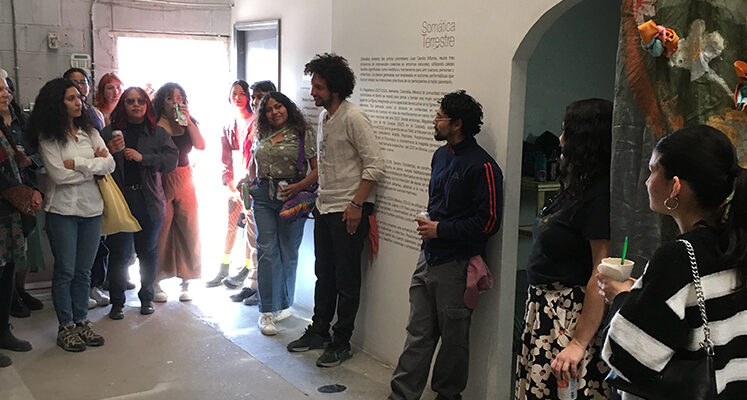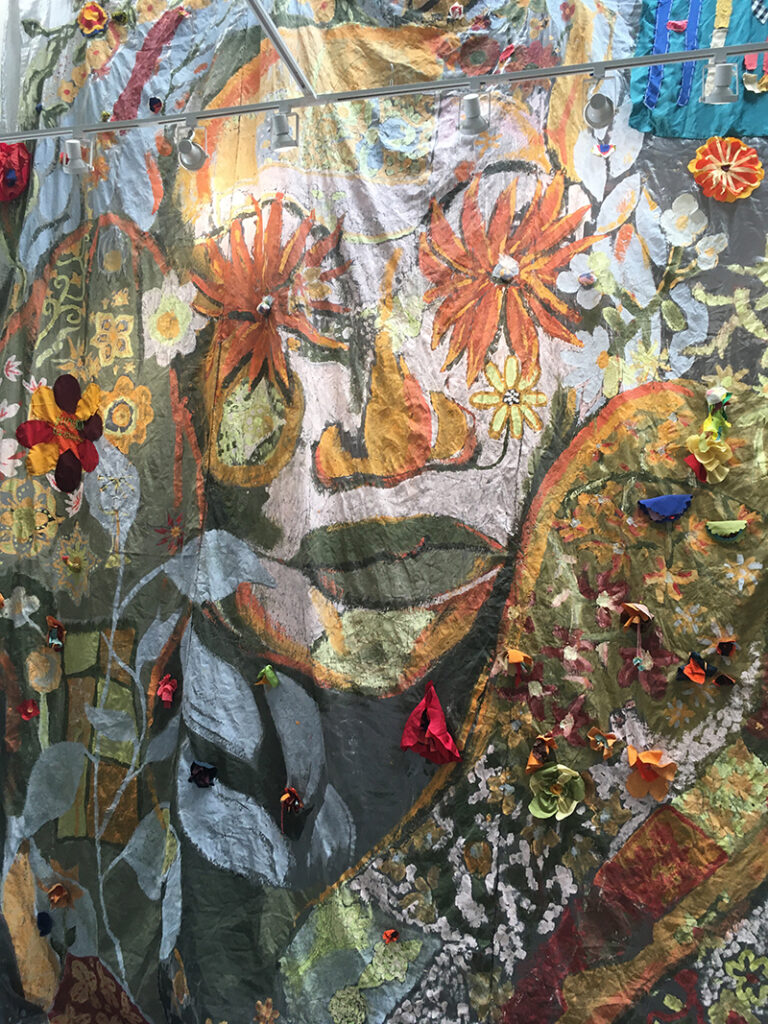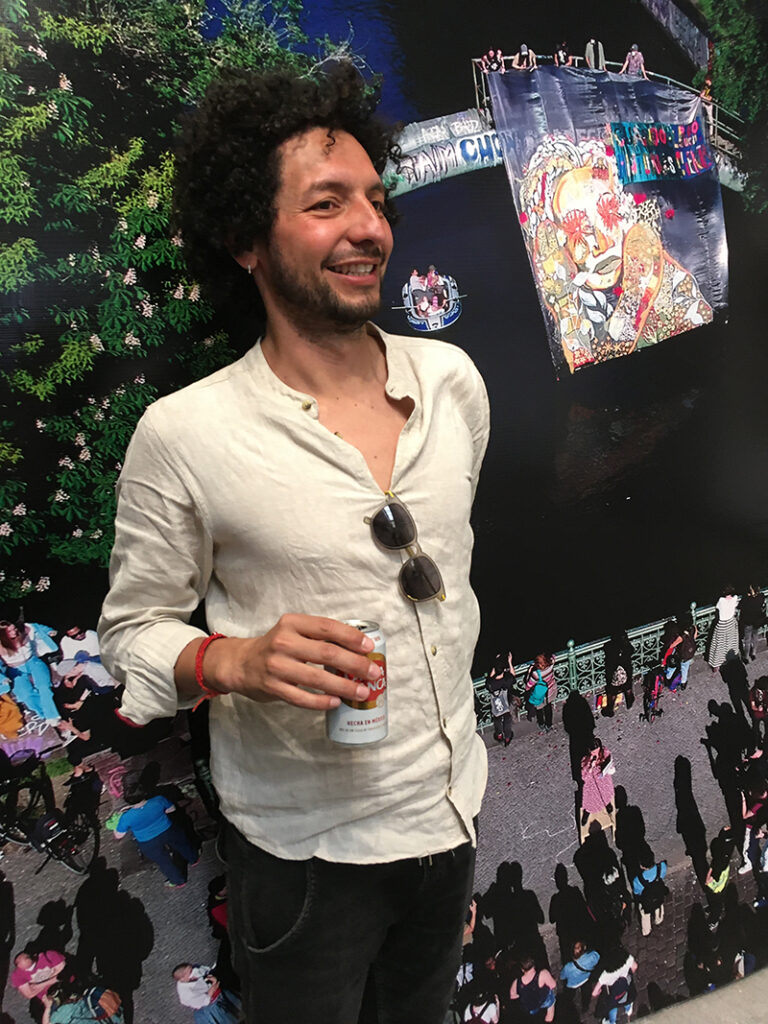By Kent Paterson
If you get a chance, you might saunter over to Ciudad Juárez to see the Somatica Terreste art exhibit. The work of Colombian artist Juan Camilo Alfonso and curated by Octavio Castrejón, the exhibit encompasses textile art, video, painting, and photography. Alfonso, who currently resides in Germany, recently spent a month in Juárez thanks to a cultural exchange between Berlin and the Mexican border city. He was on hand this month for the exhibit’s opening in the Azul Arena gallery, where he explained a collaborative process of art with like-minded friends and answered questions from a welcoming audience.
Alfonso also took time out from the lively event to speak to El Chuqueño about a work of textile-based art on display that day which stands about 24 feet tall and stretches 18 feet wide. Dubbed Magdalena by Alfonso and fellow creators, the giant piece visits violence-torn lands and crisis ridden rivers and borders across the globe.
Magdalena was recently draped from the old Black Bridge between Juárez and El Paso during the one-year anniversary memorial for the 40 detained migrants who perished while trapped in a horrendous fire that ripped through Juárez’s now-shuttered National Migration Institute facility, which was located near the Stanton Street Bridge.
Variously defining Magdalena as a “massive fabric,” a “walking mural,” a “flag” and even an “anti-flag,” Alfonso further described Magdalena as a woman who’s been “listening” to different rivers in Germany, Colombia and Mexico “that carry a lot of histories.”
Continued Alfonso, “We started this in Berlin, because in Colombia at that time, in 2021, the bodies of different people started to appear again in the rivers. So the Colombian migrant diaspora gathered to make this action there in order to channel through the waters what was going on in Colombia.”
Subsequently, Magdalena was taken to a river in Caquetá, Colombia, where a bridge was once blown up by FARC rebels after the peace process broke down in 2002, and a river in Putumayo, Colombia, which was impacted by an avalanche in 2017.
“We brought (Magdalena) specifically here to Juárez to intervene in or listen to the stories that the Rio Bravo carries in order to somehow contribute an open ear and a healing process for the people who have been affected through migration and non-migration problems that happen here, and all of the lives that have been lost in that river,” Alfonso said. “So for us, it is like a homage to that place, to those lives that somehow remain in the river.”
As a world traveler, Alfonso has seen diverse places where violence, repression and suffering mar the landscape, images of which are reflected in his art work.
Several of his pieces depict the border of the former Spanish colony of Western Sahara in northwest Africa, where a cease-fire has existed since 1991 between Morocco, which took control of most of the territory after Spain withdrew in 1975, and the Sahwari Democratic Arab Republic, the political expression of the indigenous Western Saharan people which controls a much smaller portion of the land but is recognized by 46 nations as the legitimate government, according to Wikipedia.
Alfonso gazed upon a Moroccan border wall flanked by mine fields that prevent Western Saharans from stepping foot on their homeland. Consequently, transit is absent around the wall, he said. But in the El Paso- Juárez borderland of Operation Lone Star times the artist set his eyes on a multi-legged barrier in a zone of active human transit that, in his words, constitutes an “architecture of repression” which severely cuts into and curtails passages.
“It’s not just one wall, but thousands of steel posts with gates, barbed wire, the river with cement, industrial constructions and straight angles. Then arms, humans, vehicles. It’s like a quantity of layers designed to separate,” the Colombian artist reflected. The violence represented in border barriers is different in El Paso-Juárez than in the Western Sahara, since in the former it’s “more urban, more industrial,” Alfonso contended. “I don’t know if it’s more violent, but it’s a more individualized violence.”
Colombia, Alfonso’s native country, is also far from a stranger to violence, repression and war. Since 2016, though, the South American nation has undergone momentous events that just perhaps signal a different destiny including the peace agreement between the government and FARC rebels, a 2019 popular uprising, the election of Colombia’s first leftist president, Gustavo Petro, the current peace talks between Petro’s government and the ELN guerrillas, and the Colombian government’s increased stature on the world stage.
Nonetheless, prospects for a new and transformative future are still very fragile, Alfonso opined.
“The peace process is advancing. It’s crazy because violence continues in Colombia. The war hasn’t completely stopped, but at the same time we’re also trying out a process of reconciliation, a historic reconstruction,” Alfonso added. “It’s complex to pair up a continuing war and a reconciliation process. It’s interesting to see how Colombia is starting to become a leading power on the international level with the environmental policies that the government proposes, which I believe is something essential for the coming decades. The process with the ELN is advancing, but these are processes which are moving along slower than we’d like.”
Summing up his artistic ethos, Alfonso said: “What I tend to do with my art is not just address the aesthetic and not just the political. (I) also like trying to go into the more subtle places of our existence and to try to heal them with our actions.”
The “Somatica Terreste” exhibit will be on display at the Azul Arena galley until Saturday, April 27. A rising star in Ciudad Juárez’s cultural scene, Azul Arena offers exhibits from visiting and local artists, workshops, zine presentations and poetry readings, among other events. Look for an exhibit on maquiladoras in Juarez and Taiwan coming up in May.
Free of charge, Azul Arena is open Wednesday through Friday from noon to 6 pm and Saturdays from 11 am to 3 pm. The artistic space is located in Colonia Partido Romero at 246 Bolivia, a couple of blocks south of of 16 de Septiembre and not far from the old Juárez Mercado. Look for a mural on the front of the gallery building-you can’t miss it. For more information on the Azul Arena gallery:




